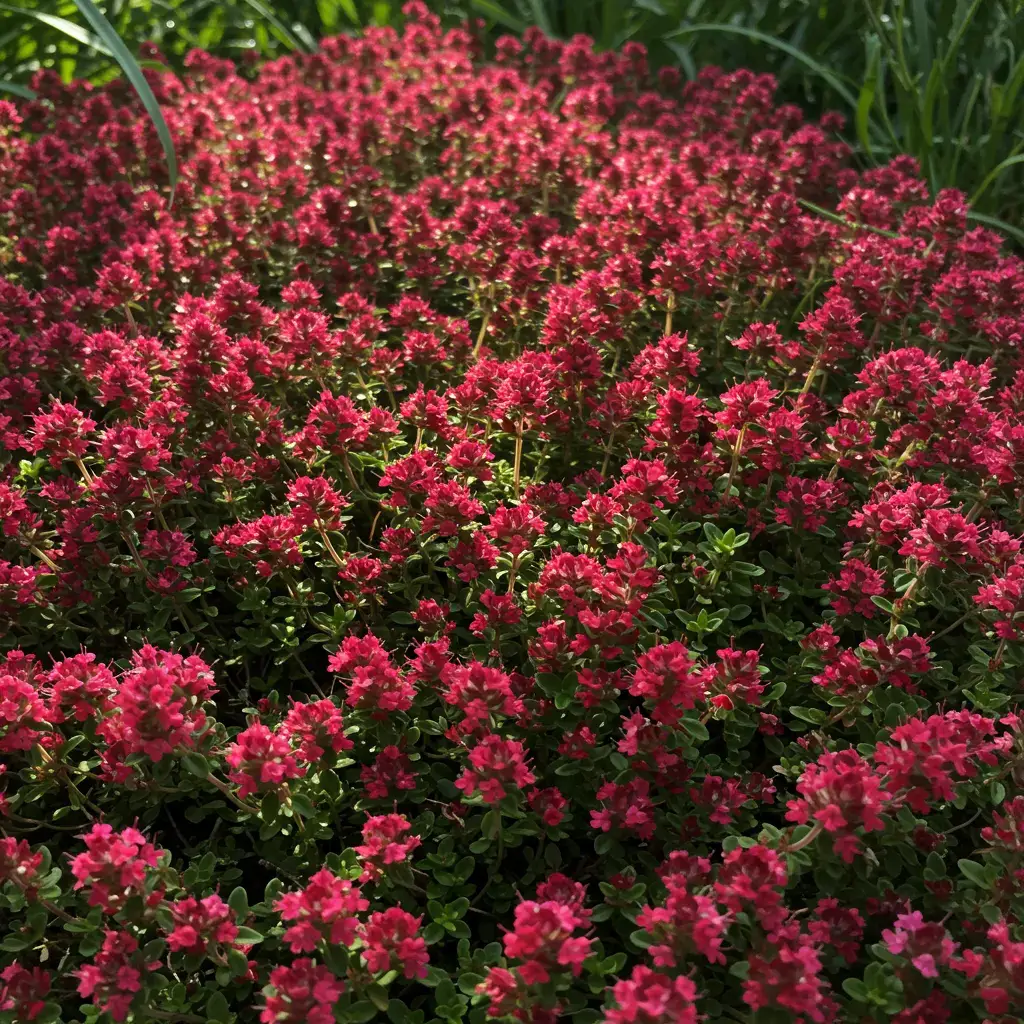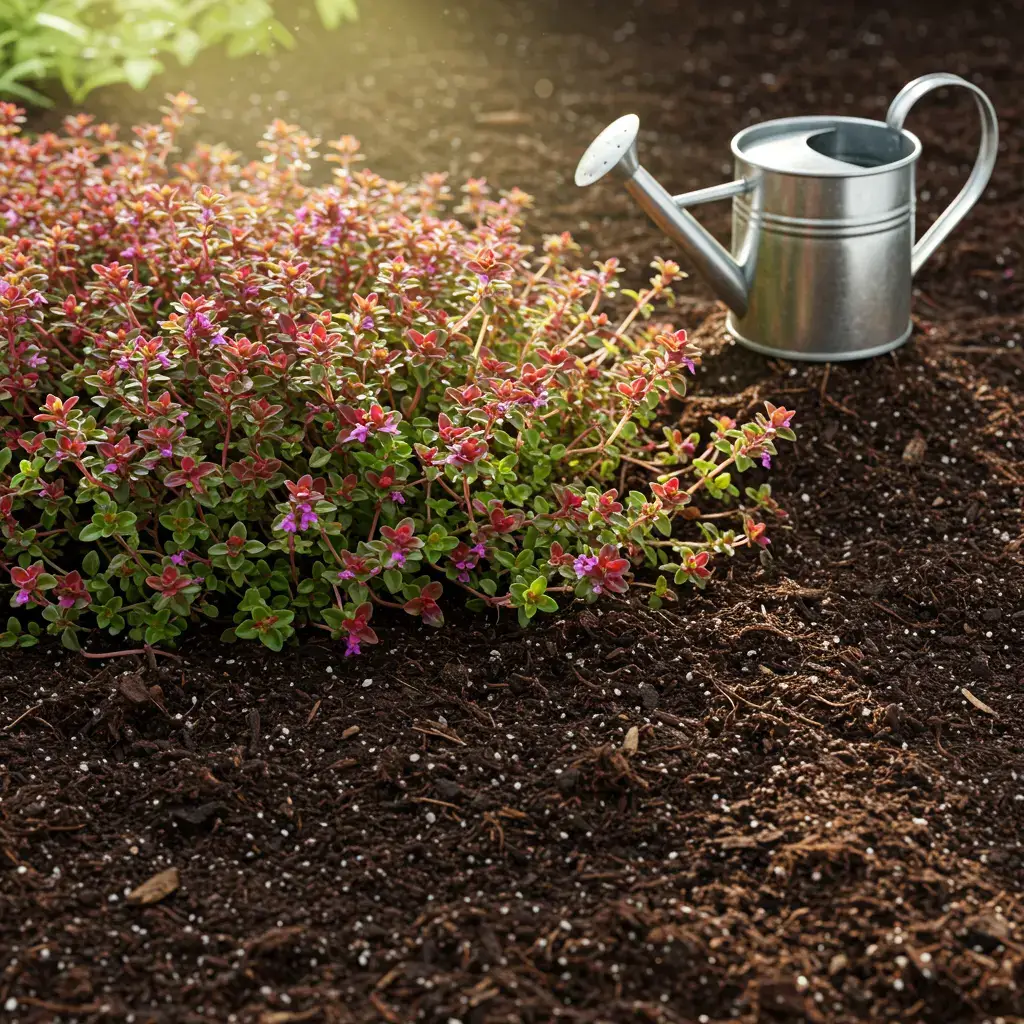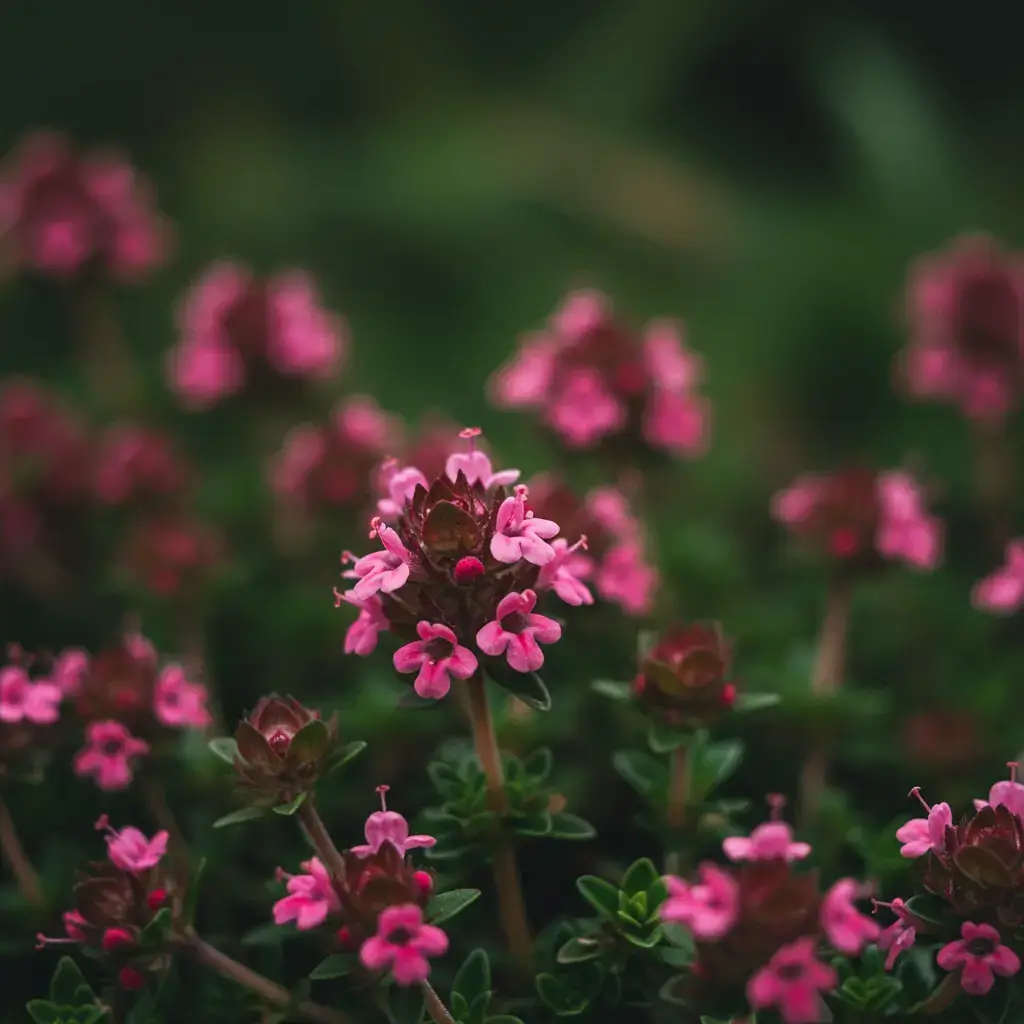Are you looking for a beautiful, low-maintenance groundcover to transform your garden?Consider creeping red thyme, a versatile and attractive option that requires minimal upkeep.This fragrant, flowering groundcover is perfect for filling gaps between pavers or cascading over walls. Its low maintenance requirements make it an ideal choice for busy gardeners or those new to gardening.
In this article, we’ll explore the characteristics and benefits of creeping red thyme and provide tips on how to incorporate it into your garden design.
Key Takeaways
- Discover the benefits of using creeping red thyme as a groundcover.
- Learn how to incorporate it into your garden design.
- Understand the low-maintenance requirements of this versatile plant.
- Explore its characteristics and how it can enhance your outdoor space.
- Find out why creeping red thyme is a great choice for busy gardeners.
Understanding Creeping Red Thyme
As you explore the world of low-maintenance groundcovers, creeping red thyme stands out for its beauty and resilience. This herb is not only aesthetically pleasing but also offers several practical benefits for gardeners.
Origin and Botanical Classification
Creeping red thyme, known botanically as Thymus serpyllum, is a member of the Lamiaceae family. Native to Europe and parts of Asia, it has been naturalized in many regions and is prized for its hardiness and adaptability.
Distinctive Characteristics
One of the defining features of creeping red thyme is its dense, spreading habit, which makes it an excellent groundcover. Let’s take a closer look at its foliage, flowers, and growth habits.
Foliage and Flowers
The foliage of creeping red thyme is characterized by small, oval-shaped leaves that are typically a vibrant green color. In the summer, it produces profuse, tiny red flowers that attract pollinators and add a pop of color to the landscape.
Growth Habits
Creeping red thyme is known for its ability to form a dense mat, suppressing weeds and erosion. It can thrive in poor soil and withstands moderate foot traffic, making it an ideal choice for areas between stepping stones or along pathways.
Benefits of Using Creeping Red Thyme in Your Garden

Incorporating creeping red thyme into your garden can be a game-changer, offering numerous benefits that enhance your outdoor space. This versatile groundcover is not only aesthetically pleasing but also provides several practical advantages. By understanding these benefits, you can make the most of creeping red thyme in your gardening endeavors.
Drought Tolerance and Water Conservation
Creeping red thyme is renowned for its drought tolerance, making it an ideal choice for water-conscious gardeners. Once established, it requires minimal watering, reducing the need for frequent irrigation. This characteristic not only conserves water but also minimizes the time spent on garden maintenance.
Minimal Maintenance Requirements
This low-growing groundcover demands very little upkeep. It doesn’t need regular mowing or pruning, although occasional trimming can help maintain its shape. The minimal maintenance requirements of creeping red thyme make it perfect for busy gardeners or those new to gardening.
Aromatic Properties and Culinary Uses
Creeping red thyme is not just a visually appealing groundcover; it also boasts aromatic properties and is used in various culinary applications. The leaves can be used fresh or dried in cooking, adding a subtle thyme flavor to dishes. Its fragrance also repels pests, creating a more balanced garden ecosystem.
| Benefit | Description |
| Drought Tolerance | Requires minimal watering once established |
| Minimal Maintenance | Low upkeep with occasional trimming |
| Aromatic Properties | Fragrant leaves for culinary use and pest control |
Ideal Growing Conditions for Creeping Red Thyme
Understanding the ideal environment for creeping red thyme is crucial for its success in your garden. This hardy, adaptable plant requires specific conditions to flourish, and by replicating these conditions, you can enjoy its numerous benefits.
Soil Requirements and Preparation
Creeping red thyme prefers well-draining soil with a slightly alkaline pH, ranging from 6.0 to 8.0. To achieve this, you can add organic matter like compost to improve soil structure and fertility. Ensure the soil is free of debris and weeds, which can compete with the thyme for water and nutrients.
- Test your soil pH to determine if it’s within the ideal range.
- Add lime to raise the pH if it’s too acidic.
- Incorporate compost to enhance soil drainage and fertility.
Sunlight and Temperature Preferences
Creeping red thyme thrives in full sun and can tolerate a range of temperatures. It prefers at least 6 hours of direct sunlight per day and temperatures between 60°F and 80°F (15°C and 27°C). While it can survive some frost, prolonged exposure to freezing temperatures may require additional protection.
To optimize sunlight, consider planting creeping red thyme in a location that receives direct sunlight for most of the day.
Climate Adaptability Across the US
One of the advantages of creeping red thyme is its climate adaptability across various regions in the US. It can thrive in USDA Hardiness Zones 4-9, making it suitable for a wide range of climates. However, in areas with extreme weather conditions, such as intense heat or cold, additional care may be necessary to protect the plant.
Planting Creeping Red Thyme in Your Landscape
To successfully integrate creeping red thyme into your landscape, understanding the optimal planting techniques is crucial. This low-maintenance groundcover can thrive in a variety of conditions, making it an ideal choice for gardeners looking to enhance their outdoor spaces.
Best Seasons for Planting
The best time to plant creeping red thyme depends on your location. In regions with mild winters, fall or early spring are ideal times for planting, allowing the thyme to establish itself before the heat of summer. In areas with harsh winters, spring planting is recommended, giving the plants a chance to grow before the cold sets in.
Spacing and Coverage Considerations
When planting creeping red thyme, it’s essential to consider the spacing to achieve the desired coverage. Plants should be spaced about 6 to 12 inches apart, depending on how quickly you want the area to be covered. Proper spacing ensures that the thyme grows evenly and fills in the gaps between plants.
Starting from Creeping Thyme Seeds
Starting creeping thyme from seeds can be a cost-effective way to cover larger areas. This process involves seed preparation and understanding the germination timeline.
Seed Preparation
Before sowing, creeping thyme seeds benefit from a period of cold stratification, which can be achieved by storing them in the refrigerator for a few weeks. This process enhances germination rates.
Germination Timeline
After sowing, creeping thyme seeds typically germinate within 1 to 3 weeks, depending on soil conditions and temperature. Keeping the soil moist during this period is crucial for successful germination.
By following these guidelines, you can successfully plant and establish creeping red thyme in your landscape, enjoying its beauty and fragrance for years to come.
Essential Care Guide for Creeping Red Thyme

To keep your creeping red thyme thriving, it’s essential to understand its care requirements. Proper care will ensure that your thyme remains healthy, fragrant, and visually appealing.
Watering Schedule and Techniques
Creeping red thyme is drought-tolerant, but it still needs adequate watering, especially during its initial growth phase. Water your thyme when the top inch of soil feels dry to the touch. Avoid overwatering, as this can lead to root rot.
A good rule of thumb is to water your creeping red thyme once a week during hot summer months and once every 10-14 days during cooler seasons. Make sure the soil drains well to prevent waterlogged conditions.
Pruning and Trimming Tips
Regular pruning is necessary to maintain the shape and promote healthy growth of your creeping red thyme. Trim back the thyme plants by about one-third after they finish blooming. This encourages new growth and prevents the plants from becoming woody.
Use scissors or pruning shears to trim the thyme, making sure to remove any dead or damaged stems. This will help maintain the plant’s appearance and prevent the spread of disease.
Fertilization Needs
Creeping red thyme has minimal fertilization needs. In fact, overfertilization can be detrimental to its health. If necessary, you can feed your thyme with a balanced, water-soluble fertilizer during the growing season. Dilute the fertilizer to half the recommended strength to avoid burning the roots.
| Care Aspect | Recommendation | Frequency |
| Watering | Water when top inch of soil is dry | Once a week (summer), once every 10-14 days (other seasons) |
| Pruning | Trim back by one-third | After blooming |
| Fertilization | Balanced, water-soluble fertilizer | During growing season (diluted to half strength) |
Creative Landscape Design Ideas with Creeping Red Thyme
Creeping red thyme offers a multitude of creative possibilities for gardeners looking to enhance their outdoor spaces. This versatile groundcover can be used in various innovative ways to add beauty and functionality to your garden.
Between Stepping Stones and Pathways
Using creeping red thyme between stepping stones and pathways is a great way to create a visually appealing and fragrant garden feature. As you walk along the path, the thyme releases its aroma, enhancing the sensory experience of your garden. To achieve this look, plant the thyme around the stepping stones, allowing it to spread and fill in the gaps.
Rock Gardens and Slopes
Creeping red thyme thrives in rock gardens and on slopes, where its spreading habit can be fully utilized. It helps to stabilize the soil, preventing erosion, and adds a pop of color with its red flowers. When planting on slopes, ensure the soil is well-draining to prevent waterlogged conditions.
Lawn Alternatives and Border Plantings
For those looking for alternatives to traditional lawns, creeping red thyme makes an excellent choice. It requires less maintenance than grass and can tolerate foot traffic. Additionally, it can be used as a border planting around gardens or walkways, adding a neat and tidy finish to your landscape design.
| Use | Benefits | Considerations |
| Between Stepping Stones | Aesthetic appeal, fragrance | Regular trimming required |
| Rock Gardens and Slopes | Soil stabilization, drought tolerance | Ensure good drainage |
| Lawn Alternatives | Low maintenance, tolerates foot traffic | May require occasional weeding |
Propagation and Purchasing Guide

To expand your creeping red thyme coverage, understanding the methods of propagation is essential. This knowledge will enable you to make the most of this versatile and low-maintenance groundcover.
Division and Cutting Methods
Creeping red thyme can be propagated through division and cutting methods. Division involves separating a mature plant into smaller sections, each with its own roots and foliage, and replanting them. Cutting involves taking stem cuttings from a healthy plant, typically in the spring or early summer, and rooting them in well-draining soil. Both methods are effective for multiplying creeping red thyme, allowing you to cover more ground with minimal effort.
Where to Buy Creeping Thyme Seeds Bulk
If you prefer to start from seeds, buying in bulk can be a cost-effective option. You can find suppliers both online and at local nurseries.
Online Suppliers of Bulk Creeping Thyme Seeds
Online retailers like Amazon, Burpee, and Seed Savers Exchange often carry a variety of creeping thyme seeds in bulk. Be sure to check reviews and product descriptions for quality and authenticity. Shopping online can offer a wider selection and competitive pricing.
Local Nursery Options
Visiting local nurseries or gardening stores in your area can also be a great way to find bulk creeping thyme seeds. The staff can often provide valuable advice on the best varieties for your local climate and soil conditions.
“Local nurseries are a treasure trove of knowledge and quality plants,”
says a seasoned gardener.
Cost Considerations and Value
The cost of creeping thyme seeds or plants can vary depending on the supplier, quantity, and quality. When calculating the cost, consider the long-term benefits of using creeping red thyme, including its drought tolerance and minimal maintenance requirements. Investing in quality seeds or plants upfront can save you money and effort in the long run.
Conclusion
As you’ve discovered, creeping red thyme is an exceptional low-maintenance groundcover that can elevate your garden’s beauty and functionality. Its drought tolerance, minimal maintenance requirements, and aromatic properties make it an ideal choice for various landscape designs.
By understanding the ideal growing conditions and essential care guide for creeping red thyme, you can successfully incorporate this versatile groundcover into your outdoor space. Whether you’re looking to create a beautiful pathway, a fragrant rock garden, or a lush lawn alternative, creeping red thyme is a great option.
With its numerous benefits and creative landscape design possibilities, creeping red thyme is sure to become a valuable addition to your garden. As you consider incorporating this low-maintenance groundcover into your landscape, you’ll appreciate its ability to thrive in a variety of conditions, making it perfect for gardeners of all skill levels.

